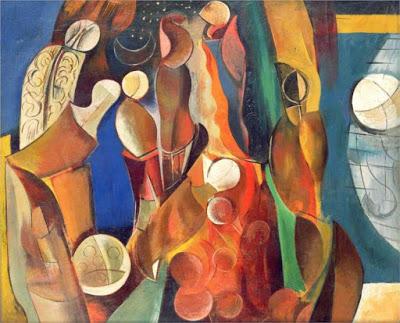
Creation Myth by Wyndham Lewis
There are so many myths about the yoga tradition that get passed on from teacher to student and then to those student’s students and so on. And often these myths even get published in reputable publications. Here’s an example from Yoga Journal Magazine.Also known as yogic sleep or sleep with awareness, Yoga Nidra is an ancient practice that is rapidly gaining popularity in the West. It is intended to induce full-body relaxation and a deep meditative state of consciousness. "We live in a chronically exhausted, overstimulated world," says Rod Stryker. "Yoga Nidra is a systematic method of complete relaxation, holistically addressing our physiological, neurological, and subconscious needs.” — Stephanie Levin-Gervasi, “Find Full-Body Relaxation in Yoga Nidra” in Yoga Journal Magazine
The myth above is the part about Yoga Nidra being an ancient practice. Although the term itself is ancient (it originally was just a synonym for the state of deep meditation that we usually called samadhi), the practice that Rod Stryker describes as “a systematic method of complete relaxation, holistically addressing our physiological, neurological, and subconscious needs” is a modern practice. And the rest of the article Find Full-Body Relaxation in Yoga Nidra is a confusing mishmash of modern Yoga Nidra with ancient descriptions of meditation. (My source for my understanding of the myth vs. reality above is the paper “YOGANIDRA: An Understanding of the History and Context” by Jason Birch and Jacqueline Hargreaves.)
Unfortunately, many of the myths that continue to be circulated are about quite important issues, including that Patanjali’s Yoga Sutras was the most important text on yoga in India and for Ashtanga yoga that the primary series was discovered in an ancient manuscript. Although myth busting isn’t one of my main goals for this my work on this blog, when I’m writing about a topic that has myths associated with it, I do try to separate myth from fact. And it this takes quite a bit of research, I can tell you. But my independent yoga studies (which are ongoing), particularly the books The Yoga Body by Mark Singleton, The Yoga Tradition at the Mysore Palace, by NE Sjoman, and The Yoga Tradition by Georg Feuerstein, have led me to be suspicious about many claims I hear. Then, when I’m suspicious, I look a bit deeper into the subject.
Because Jivana and I just went down a rabbit hole together regarding the origins of Yoga Nidra (a place I’ve been before but because he was questioning me I wanted to double-check just in case), I started to think about why this matters so much to me. In some cases, believing a myth can lead to actual harm. For example, the myth that the Ashtanga primary series is an ancient and perfect practice (rather than a beautiful yoga performance piece choreographed by Krishnamacharya and Jois to show off the asana practice as form of advertising the practice) has surely led to a large number of physical injuries. But how does it hurt people to believe that Yoga Nidra is an ancient practice when it was actually developed in the 20th century by Swami Satyananada (see Friday Q&A: What is Yoga Nidra?) or that for centuries in India the Yoga Sutras was a relatively minor work and it was Swami Vivekananda who popularized it in the west in the late 19th century?
In general this whole habit of believing concepts and practices are ancient and therefore perfect can lead to a lack of questioning, which is never a good thing. And while some of these myths may have arisen from lack of understanding (the fact that there was an ancient term “yoga nidra” could have led people to become confused about how that term related to the modern Yoga Nidra practice), in other cases, some were intentionally fostered to make a practice more appealing and possibly less open for debate.
But more importantly the truth matters. And from the very beginning of this blog, we committed to being fact-based in our discussions about aging, science, medicine, and yoga. And when there are things for which we don’t have proof we are honest in saying that we are drawing conclusions from our personal experience or from anecdotal evidence. This practice of being truthful and fact-based in our writing actually takes a lot of behind-the-scenes work on my part as I do fact checking on posts written by others via my own research and discussions with Brad when I notice something that seems scientifically sketchy to me.
And for yoga history and philosophy, I’m attempting to apply the same kind of rigor. I try to be as accurate as possible and if learn a practice is actually modern or a philosophical concept is just a modern interpretation of ancient idea that was quite different, I will say so. And when I find errors in a post after the fact, which I often do as I continue to educate myself, I will go back and correct them or ask the original author to do so (as I did with Baxter and his post on avidya, ignorance, which you can see at Richard Rosen Clarifies the Meaning of Avidya.
I must admit this self-assigned commitment to truth feels a bit overwhelming at times, and I fear that I often miss important things. But I tell myself I will just try my best. And that's my promise to you as well as to myself.
Subscribe to Yoga for Healthy Aging by Email ° Follow Yoga for Healthy Aging on Facebook and Twitter ° To order Yoga for Healthy Aging: A Guide to Lifelong Well-Being, go to Amazon, Shambhala, Indie Boundor your local bookstore.For information about Nina's upcoming workshops and retreats and other activities, see Nina's Workshops, Book Signings, and Books.

